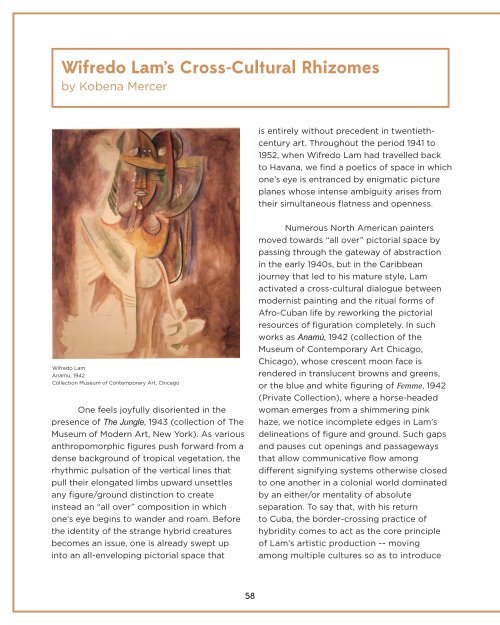Kobena Mercer – Wifredo Lam’s Cross-Cultural Rhizomes
Excerpt from “Lam/Basquiat”, a catalog published by Galerie Gmurzynska on the occasion of a special presentation at Art Basel 2015, prepared in collaboration with Annina Nosei.
Excerpt from “Lam/Basquiat”, a catalog published by Galerie Gmurzynska on the occasion of a special presentation at Art Basel 2015, prepared in collaboration with Annina Nosei.
You also want an ePaper? Increase the reach of your titles
YUMPU automatically turns print PDFs into web optimized ePapers that Google loves.
Wifredo <strong>Lam’s</strong> <strong>Cross</strong>-<strong>Cultural</strong> <strong>Rhizomes</strong><br />
by <strong>Kobena</strong> <strong>Mercer</strong><br />
is entirely without precedent in twentiethcentury<br />
art. Throughout the period 1941 to<br />
1952, when Wifredo Lam had travelled back<br />
to Havana, we find a poetics of space in which<br />
one’s eye is entranced by enigmatic picture<br />
planes whose intense ambiguity arises from<br />
their simultaneous flatness and openness.<br />
Wifredo Lam<br />
Anamu, 1942<br />
Collection Museum of Contemporary Art, Chicago<br />
One feels joyfully disoriented in the<br />
presence of The Jungle, 1943 (collection of The<br />
Museum of Modern Art, New York). As various<br />
anthropomorphic figures push forward from a<br />
dense background of tropical vegetation, the<br />
rhythmic pulsation of the vertical lines that<br />
pull their elongated limbs upward unsettles<br />
any figure/ground distinction to create<br />
instead an “all over” composition in which<br />
one’s eye begins to wander and roam. Before<br />
the identity of the strange hybrid creatures<br />
becomes an issue, one is already swept up<br />
into an all-enveloping pictorial space that<br />
Numerous North American painters<br />
moved towards “all over” pictorial space by<br />
passing through the gateway of abstraction<br />
in the early 1940s, but in the Caribbean<br />
journey that led to his mature style, Lam<br />
activated a cross-cultural dialogue between<br />
modernist painting and the ritual forms of<br />
Afro-Cuban life by reworking the pictorial<br />
resources of figuration completely. In such<br />
works as Anamú, 1942 (collection of the<br />
Museum of Contemporary Art Chicago,<br />
Chicago), whose crescent moon face is<br />
rendered in translucent browns and greens,<br />
or the blue and white figuring of Femme, 1942<br />
(Private Collection), where a horse-headed<br />
woman emerges from a shimmering pink<br />
haze, we notice incomplete edges in <strong>Lam’s</strong><br />
delineations of figure and ground. Such gaps<br />
and pauses cut openings and passageways<br />
that allow communicative flow among<br />
different signifying systems otherwise closed<br />
to one another in a colonial world dominated<br />
by an either/or mentality of absolute<br />
separation. To say that, with his return<br />
to Cuba, the border-crossing practice of<br />
hybridity comes to act as the core principle<br />
of <strong>Lam’s</strong> artistic production -- moving<br />
among multiple cultures so as to introduce<br />
58
















